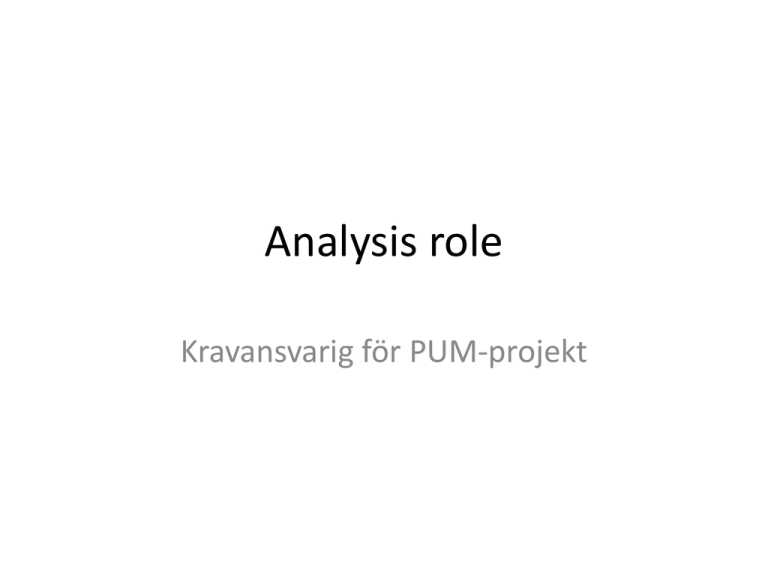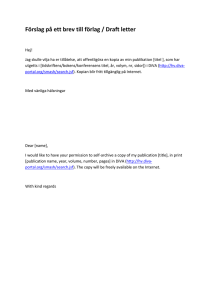Analysis role Kravansvarig för PUM-projekt
advertisement

Analysis role
Kravansvarig för PUM-projekt
Ansvar för
•
•
•
•
•
Glossary
Use-cases
Use-case model
System-wide requirements
Vision
• Kundkontakter
• Förhandlingspart och orakel in mot övriga
gruppen
• Mycket kontakter med arkitekten, sedan testaren
Actor: a user of
the system in a
particular role.
Can be human
or system.
Use-case diagram
Borrow copy of book
BookBorrower
Detail of use-case
A BookBorrower presents a book.
The system checks that the potential
borrower is a member of the library,
and that he/she doesn’t already have
the maximum permitted book on loan.
This maximum is 6 unless the
member is a staff member, in which
case it is 12. If both checks succeed, the
system records that this library member
has this copy of the book on loan.
Otherwise it refuses the loan.
Please, keep as
simple as possible.
Relations between use-cases
Extend loan
<<include>>
Check for
reservation
BookBorrower
Borrow copy
of book
<<include>>
”Reuse”
<<extend>>
Stereotype: extended
classification of meaning
Refuse loan
”Separating scenarious”
Identifying classes: noun analysis
A BookBorrower presents a book.
The system checks that the potential
borrower is a member of the library,
and that he/she doesn’t already have
the maximum permitted book on loan.
This maximum is six unless the
member is a staff member, in which
case it is 12. If both checks succeed, the
system records that this library member
has this copy of the book on loan.
Otherwise it refuses the loan.
•book – real noun handled by
the system
•system – meta-language
•borrower – already actor
•library member – handled by
the system
•staff member – handled by the
system
•checks – event
•copy of book – handled by the
system
The single class model
Book
name
title: String
attribute
copiesOnShelf() : Integer
borrow(c:Copy)
operations
The library class model
Book
1
is a copy of
1..*
LibraryMember 0..1
MemberOfStaff 0..1
borrows/returns
0..*
Copy
0..*
Journal
generalisation
borrows/returns
Where to go now?
1. Continue with a traditional specification
2. Writing a detailed use-case specification
3. Continue modelling
Writing a detailed use-case
specification
• Name
• Brief Description
• Flow of Events: Write the description so that the
customer can understand it. The flows can include a
basic flow, alternative flows, and sub flows.
• (Key scenarios)
• Special Requirements
• Preconditions
• Post-conditions
• Extension points
“Classical” use-case specification
max 40 pages
Use-cases need System-wide
requirements
1. Introduction
2. System-Wide Functional
Requirements
3. System Qualities
3.1
3.2
3.3
3.4
Usability
Reliability
Performance
Supportability
4. System Interfaces
4.1 User Interfaces
4.1.1 Look & Feel
4.1.2 Layout and Navigation Requirements
4.1.3 Consistency
4.1.4 User Personalization & Customization
Requirements
4.2 Interfaces to External Systems or
Devices
4.2.1 Software Interfaces
4.2.2 Hardware Interfaces
4.2.3 Communications Interfaces
5. Business Rules
6. System Constraints
7. System Compliance
7.1 Licensing Requirements
7.2 Legal, Copyright, and Other Notices
7.3 Applicable Standards
8. System Documentation
Continue modelling :Sequence
diagram
theLibraryMember:
LibraryMember
theCopy: Copy
theBook: Book
aMember:
BookBorrower
A
{C-A < 5s}
C
borrow(theCopy)
1: okToBorrow
2: borrow
{borrowed’ –
borrowed < 1s}
2.1: borrowed
Combining fragments of
sequence diagrams
SD processOrder
:Order
:TicketDB
:Account
create
ref
Get existing customer data
loop
loop
[get next item]
reserve(date,no)
loop condition
add(seats)
answer
destruction
More fragments of sequence
diagrams
:Order
:TicketDB
loop
[get next item]
reserve(date,no)
alt
[available]
guard condition
nested conditional
add(seats)
alternate branches
reject
[unavailable]
Continue modelling: next level
Next level Use-case
State diagram
For class Copy:
start marker
object
on loan
message this object
return()/book.returned(self)
on the shelf
borrow()/book.borrowed(self)
state
event, causing
transition
action, reaction
to the event
State diagram with guards
Wiht OCL, Object Constraint
Language, this becomes very
powerful
For class Book:
returned()
not borrowable
returned()
borrowable
borrowed()[last copy]
borrowed()[not last copy]
Deployment diagram
hardware
august: Workstation
lotta: PC
<<LAN>>
<<artifact>>
<<artifact>>
